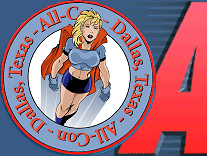

Judging Criteria for ALL-CON Model Contest
(Adapted from the Mackowski Guidelines)
For modelers who are looking for that extra advantage to help them win a trophy, and to provide some guidance to judges who have to evaluate space and science fiction categories, I put together the guidelines in this article. Because these categories are so unique, and because they encompass so many types of models (airplane-like vehicles, robots, figures, boxy satellites, sleek science fiction ships, real space capsules, etc.), it is difficult to come up with general guidelines that cover all possible entries. Additionally, when it comes to judging, there are no rigid standards or hard criteria that can never be violated. Therefore, I will first provide some general suggestions on workmanship, followed by hints on more specific areas. I certainly welcome any comments and additions that readers may have on this topic.
Categories
Science Fiction Vehicle, Air/Space
Science Fiction Vehicle, Ground/Aquatic
Prop Replica
Mecha
Figure/Diorama
Special Awards
Best Scratchbuilt
Junior Achievement
Best In Show
Basic Workmanship
These general ground rules are the most common, and they apply to space modeling as much as they do to aircraft, armor, ships, or cars.
Basic construction is the first thing a judge will look at. There should be no seams, glue marks, or sanding scratches. Joints should be filled where necessary. For scratchbuilt ships, make sure that the construction and detailing are uniform and to scale. That is, if you are going to have some panel lines or joints showing, be sure to do so consistently over the entire surface of the model. Along with basic construction technique comes basic alignment. If modeling a winged or finned vehicle, all wings/fins should achieve the same dihedral angle and sweep; similarly, landing gear should be symmetrical in angle to the body of the ship and to the ground.
Paint should be smooth and uniform, with no smudges, runs, or fingerprints. Colors can be almost anything, especially for scratchbuilt fantasy spaceships. If building a model of a ship seen on television or in a film, try to match the on-screen appearance as much as possible.
Weathering, if done at all, should be subtle and to scale. Certainly a "used" fantasy spaceship can be fairly weathered, but the effect should not be overdone or sloppy. Never try to use excessive weathering to cover up a flawed paint job!
Decals should be of uniform finish (important if you are kit-bashing and getting decals from multiple sources) and have no film showing.
Rocket engine nozzles should generally have some sort of weathering, particularly on the inside. Photos of the Apollo vehicles in space show no weathering on the outside of the Service Module main engine, but the exterior of a Shuttle main engine shows multiple tones of black and metallic gray. The inside of a rocket nozzle should be streaked from the exhaust, and the exterior might show discoloration from high-temperature effects, much like the afterburner on a jet fighter. Small thrusters and steering rockets should be drilled or otherwise hollowed out, not solid.
Real Spacecraft
Re-entry vehicles (Space Shuttle, Apollo, etc.) should have some sort of aerodynamic weathering if they are modeled in a post-entry or landing mode.
Any scratchbuilt craft should supply references so that the judges have sufficient data to check details and accuracy. With the lack of kits - and references - in this field, back-up material is essential so that judges know the extent of your work.
Many kits that feature antennas (the 1/48th scale Lunar Modules come to mind) need to have the antennas replaced. The kit versions often appear too "fat" and lacking in detail.
Science Fiction and Fantasy Vehicles
When parts are added for detailing or texture, keep scale effects in mind. Conduits and pipes on a 1/200th scale model should be much smaller than those on a 1/32nd scale vehicle. Many science fiction kit-bashers forget this.
Concerning these added details, do they look useful and truly part of the ship, or have they been added just for "artistic effect" and look like they have just been slapped on? If the modeler used parts from other kits, has the source been disguised enough so that it isn't immediately obvious where the parts came from? There is nothing wrong with using parts from other kits (armor, ships, etc.), but seeing hub-caps, automobile transmissions, and tank hulls glued onto fantasy spaceships can distract from an otherwise well-done model.
Science Fiction and Fantasy Figures
For Scratchbuilt Figures: Anatomy Rules!!! If portraying a human, make sure proportions and musculature are realistic to the subject matter.
Just as in vehicles, basic workmanship is the key criterion and literally eliminates 90% of all submitted works. If a glue joint or seam is visible, it will eliminate your figure from serious competition.
Model Show Sponsored and operated by

|


